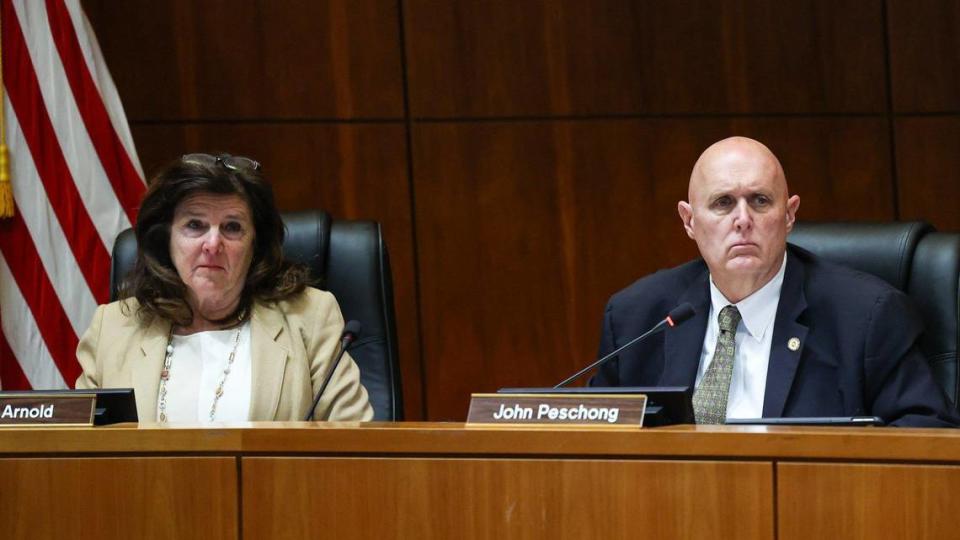SLO County supervisors move to create independent redistricting commission
- Oops!Something went wrong.Please try again later.
Voters, rather than elected officials, may get to choose San Luis Obispo County’s supervisor district boundaries in the future.
On Tuesday, the San Luis Obispo County Board of Supervisors voted 3-2 to direct staff to draft a proposal for an independent redistricting commission.
The commission would be an appointed, nonpartisan group of citizens that replace the board in approving district boundaries.
“The intent here is to, in fact, take the power away from this board — elected officials — and give it to a group that can look at (the district boundaries) in an unbiased and impartial way,” Supervisor Jimmy Paulding said.
Community members asked for an independent redistricting commission after the previous board majority approved a radically redrawn district map that was presented by citizen Richard Patten and favored Republicans in 2021.
San Luis Obispo County Citizens for Good Government, a local group that formed in response to the redistricted map, sued the county, arguing that the map was gerrymandered. The SLO County League of Women Voters joined the lawsuit. On March 21, the new board settled the lawsuit and selected a new map.
“I think we need this more than ever because the public’s trust was eroded and eviscerated by the actions of the prior board, which I do believe were consistent with gerrymandering,” Paulding said.
Supervisors Debbie Arnold and John Peschong, however, voted against the redistricting commission. They argued that the map selection process complied with the law.
“This map created districts that were swing districts or purple districts,” Peschong said. “You have three people up here that that won their seats against candidates that you said they shouldn’t have won.”
Arnold prefers a “direct method” where the board selects the map.
“I just think that things run smoother when the busy voting citizens have less complication,” she said, noting that constituents can vote against board members in the next election if they don’t like the district boundaries.
The board also directed staff to plan a study session for constituents to provide feedback on the design of the commission, before placing the proposal on the November 2024 ballot for voters’ consideration.
“Through the public hearing process, we should be able to get enough feedback from the community to ultimately put this on the ballot and give the voters the decision,” Paulding said.
The board must create the redistricting commission proposal by June 18, 2024, to add it to the November 2024 ballot, the staff report said.

What are the county’s options?
Every 10 years, the county updates the boundaries of its five supervisorial districts based on population changes shown by the Census.
Historically, the board has selected the district map, but the California Elections Code also empowers the board to establish a redistricting commission to assist with map selection, county counsel Rita Neal said at the meeting.
The county could choose from three types of redistricting commissions.
An advisory commission would recommend maps to the board, but the supervisors could still vote to select a different map.
Alternatively, a hybrid commission would recommend two or more maps that the board must choose from.
For the third option, an independent redistricting commission would adopt a district map on behalf of the board, Neal said.
The board majority preferred an independent redistricting commission.
“This is about empowering the voting public and getting away from the fact and the perception that an elected body is going to choose its voters,” Supervisor Bruce Gibson said.
The California Elections Code sets criteria for the commissioners. For example, county supervisors can’t appoint commissioners, Neal said.
State code also disqualifies applicants who previously served as a county supervisor, worked for a supervisor or their campaign, worked for a political party central committee, contributed more than $500 to a supervisorial candidate, or had been registered to lobby the board during the past eight years, Neal said.
The commission must hold three public hearings before adopting the map and follow the Fair Maps Act during the process, according to state code.

Independent redistricting commissions are growing in popularity, Neal said.
In November 2018, Santa Barbara County voters passed a ballot measure to create an independent redistricting commission.
Santa Barbara County’s 11 commissioners must be registered to vote in the county and show experience with “analytical skills relevant to the redistricting process and voting rights, ability to comprehend and apply applicable state and federal legal requirements, ability to be impartial, (and) an appreciation for diverse demographics and geography of the county,” Neal’s report said.
Because a ballot measure created the commission, it can only be altered or disbanded by a vote of the people.
In Los Angeles, Riverside, San Diego, Fresno and Kern counties, special legislation at the state level created independent redistricting commissions.
Those commissions follow similar rules but have 14 commissioners instead of 11, along with stricter requirements for commission applicants.
All six counties have similar processes for applying to serve on the commission.
Individuals apply to the county’s elections official, who selects a certain number of qualified applicants per supervisorial district.
In Santa Barbara County, the official selects nine applicants per district, for a total of 45 people. The district attorney then appoints five applicants from the qualified pool, and those five then vote to appoint the remaining six commissioners, Neal said.
In the other five counties, the elections officials select 60 total applicants. The auditor-controller then names eight people to the commission, and those people then vote to appoint the six others, according to Neal.
The board majority preferred the rules proposed by the state but agreed that an 11-member independent redistricting commission is more appropriate for a smaller jurisdiction like SLO County.
Paulding acknowledged constituent concerns that commissioners can also have bias but said the application processes Neal presented are “about as good as you can do to ensure that you get the right people — nonpartisan and impartial people.”

